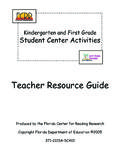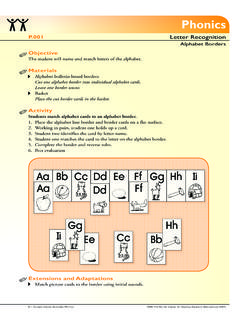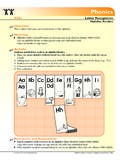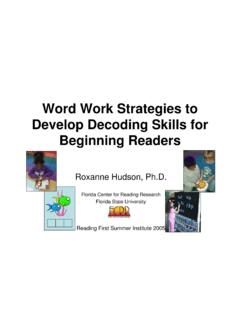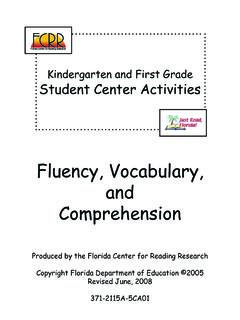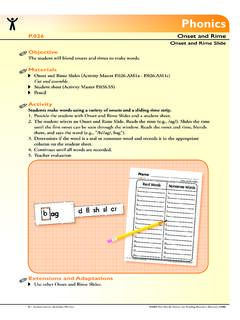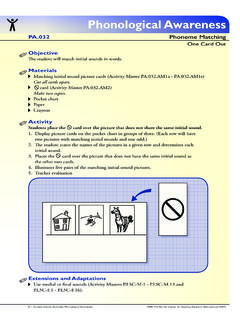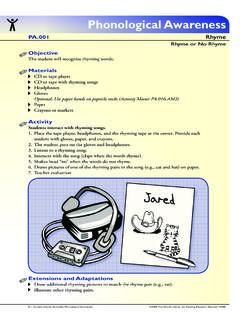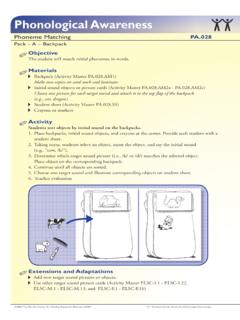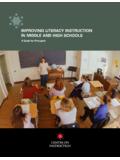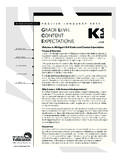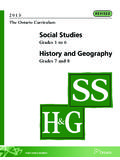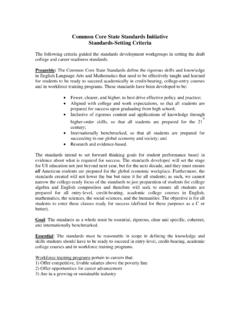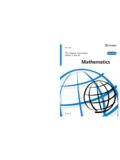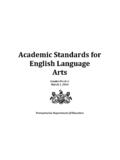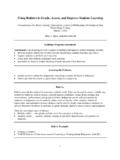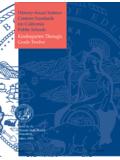Transcription of Fourth and Fifth Grade Student Center Activities
1 Fourth and Fifth GradeStudent Center ActivitiesProduced by the florida Center for reading ResearchCopyright 2007 florida Department of Education 371-96443-6SP012007 The florida Center for reading ResearchTeacher Resource Guide4-5 Student Center Activities : Teacher Resource GuideAcknowledgementsWe would like to thank the following individuals and organizations for their contributions to this Read, florida ! Office at the florida Department of EducationEvan Lefsky, Elzie, Miller, Development Team at FCRRM arcia Kosanovich, Logan, Weinstein, Kelly Magill, Review Team at FCRRG eorgia Jordan, Wahl, Van Sciver, Rissman, Arndt, , CCCT echnology Services at FCRRP eter Lenkway, Roehrig-Bice, Hoak, Cooper, Projects Group at FCRRKarl Hook, Brooke, Programs at FCRRR andee Winterbottom, Curran, StaffJoseph Torgesen, Cook, Montgomery, Development DVD ProductionRyan Ziglar, Video Production ManagerMarilyn Jackson-Rahming, Principal, Pineview Elementary, Tallahassee, FloridaBarbara Mitchell, reading Coach, Pineview Elementary, Tallahassee, FloridaHarriet Waas, Fourth Grade Teacher, Pineview Elementary, Tallahassee, FloridaVenesha Reed, Fourth Grade Teacher, Pineview Elementary, Tallahassee, FloridaKeyvette Pendleton, Fourth Grade Teacher, Pineview Elementary, Tallahassee.
2 Florida2007 The florida Center for reading ResearchTeacher Resource Guide4-5 Student Center Activities : Teacher Resource Guide2007 The florida Center for reading ResearchTeacher Resource Guide4-5 Student Center Activities : Teacher Resource Guide2007 The florida Center for reading ResearchTeacher Resource Guide4-5 Student Center Activities : Teacher Resource GuideIntroductionThis Teacher Resource Guide accompanies the Fourth and Fifth Grade (4-5) Student Center Activities developed by the florida Center for reading research and funded by Just Read, florida !. It is designed to assist teachers in differentiating instruction by using independent Student Center Activities that support skill building in four of the five components of reading (Phonics, Fluency, Vocabulary, and Comprehension). This Teacher Resource Guide is accompanied by a Professional Development DVD which discusses and illustrates important elements when implementing Student Centers in a classroom. During the spring 2004 florida reading First school site visits, staff from the florida Center for reading research (FCRR) determined that teachers may benefit from classroom materials that would be immediately useful in implementing independent Student Center Activities .
3 In 2004-2005, a team of teachers at FCRR reviewed current research , collected ideas, and created materials for use in kindergarten and first Grade classrooms. These Student Center Activities (K-1 Project), Teacher Resource Guide, and accompanying Professional Development DVD can be accessed at: In 2005-2006, a team of teachers at FCRR reviewed current research , collected ideas, and created materials for use in second and third Grade classrooms. These Student Center Activities (2-3 Project), Teacher Resource Guide and accompanying Professional Development DVD can be accessed at: the K-1 and 2-3 Projects were implemented in reading First schools and many other schools across florida , requests came for Student Center Activities for grades four and five. In 2006-2007, FCRR developed Student Center Activities for Fourth and Fifth grades (4-5 Project). The 4-5 Project includes a DVD containing Professional Development and three books: 1. Advanced Phonics and Fluency Student Center Activities2.
4 Vocabulary and Comprehension Student Center Activities3. Teacher Resource Guide (accompanied by a DVD) The first two books contain Activity Plans and Activity Masters ready for immediate use in classrooms. The third book is an informative guide offering important insights on differentiated instruction and how to use the Student Center materials. When considering florida s formula, 5 + 3 + ii + iii = No Child Left Behind, please note that four of the five reading components are covered in the Fourth and Fifth Grade Student Center Activities . The Activities will directly support your efforts to provide effective initial instruction, because they will help you provide differentiated instruction to meet the needs of every child. I hope you and your students enjoy these Activities , Marcia L. Kosanovich, Director of Curriculum and Instructional Projects florida Center for reading research 2007 The florida Center for reading ResearchTeacher Resource Guide4-5 Student Center Activities : Teacher Resource Guide2007 The florida Center for reading ResearchTeacher Resource Guide4-5 Student Center Activities : Teacher Resource Guide2007 The florida Center for reading ResearchTeacher Resource Guide4-5 Student Center Activities : Teacher Resource GuideTable of Contents Frequently Asked Questions Why should Student Center Activities be implemented in Fourth and Fifth grades?
5 What is differentiated instruction? What is a reading Center ? What are examples of reading Centers and Activities ? How are these reading Centers different from the Centers of the past? Should all five components of reading (even Phonemic Awareness) be included in Fourth and Fifth Grade reading instruction and Centers?Five Components of reading Instruction Phonemic Awareness Phonics Fluency Vocabulary Comprehension Implementing and Managing Student Centers in the Classroom Form Flexible Groups Based on Assessment Identify Appropriate Center Activities Based on Assessment Design Center Management System Implement a Behavior Management System Give Explicit Center Directions Organize the Classroom Manage Transitions Establish AccountabilityInterpretation and Implementation of Activity Plans Overview Preparing and Organizing Materials Setting Up Centers Computer-Based Centers Selecting Quality Computer Software and Technology-Based Curricula Materials Materials Needed for 4-5 Student Center Activities Crosswalk Activity Number and Subcomponent DIBELS Measures Fourth Grade Sunshine State Standards Fifth Grade Sunshine State Standards Glossary & References 15173141652007 The
6 florida Center for reading ResearchTeacher Resource Guide4-5 Student Center Activities : Teacher Resource Guide2007 The florida Center for reading ResearchTeacher Resource Guide4-5 Student Center Activities : Teacher Resource Guide2007 The florida Center for reading ResearchTeacher Resource Guide14-5 Student Center Activities : Teacher Resource GuideFrequently Asked Questions Concerning reading Centers 1. Why should Student Center Activities be implemented in Fourth and Fifth grades? A large number of students in this country are struggling to become proficient readers by Fourth Grade . The National Assessment of Educational Progress (NAEP), which has been administered to 4th and 8th Grade students since 1971, reports that Student performance in reading has been extremely stable over almost a 30-year period. On the 2003 assessment, 37% of all Fourth graders performed below the basic level, which indicates that they do not have sufficient reading skills to adequately support Grade level work that involves reading (Torgesen, 2005).
7 To help students become proficient readers, it is important to: provide explicit, differentiated reading instruction for all students offer engaging opportunities for all students to practice reading facilitate an organized classroomImplementing Center Activities can be an efficient and effective way to help accomplish this. A critical factor in implementing Student Center Activities successfully is to focus on the individual needs of students . This is best achieved in small groups where teachers can focus on specific skills and scaffold instruction based on individual needs. Small group instruction has been found to benefit Student learning, especially those who struggle to learn to read (Foorman & Torgesen, 2001). In order to teach effectively in small groups, the instructional time is uninterrupted and the students who are not in the small group at the Teacher-Led Center spend their time productively. Student Center Activities provide a way for those students who are not working with the teacher to be academically engaged in meaningful, reading -related Activities .
8 students have most likely experienced Student Centers in kindergarten through third Grade and understand the procedures and responsibilities. Continuing this routine in Fourth and Fifth grades allows the teacher to focus on the needs of small groups of students (at the Teacher-Led Center ), allows students to practice skills (at Student Centers), and continues the development of responsible behaviors for the students . When the Student Center Activities and expected behaviors have been explicitly taught and practiced well, all students will be academically engaged whether working at independent Student Centers or with the teacher at the Teacher-Led Center . 2. What is differentiated instruction? Differentiated instruction involves matching instruction to meet the diverse needs of learners in a classroom. When considering the florida formula 5 + 3 + ii + iii = No Child Left Behind (see Table 1), it is important to keep in mind that differentiated instruction is part of initial instruction (ii).
9 After a whole group lesson, Centers provide time for teachers to effectively differentiate instruction to meet the needs of all students . This can be accomplished by the teacher working with an individual or with a small group of students at the Teacher-Led Center while the other students practice, demonstrate, and extend skills independently at the Student Centers. This is an ideal time to keep students actively, yet academically, engaged and motivated during reading instruction (which consists of a minimum of 90 minutes of uninterrupted instruction). reading Centers can also provide time for classroom teachers or other reading specialists to implement immediate intensive intervention (iii) with individuals or small groups of students (in addition to the 90 minutes of instruction).Frequently Asked Questions Concerning reading Instruction 2007 The florida Center for reading ResearchTeacher Resource Guide24-5 Student Center Activities : Teacher Resource Guide3. What is a reading Center ?
10 A reading Center is a place where students engage in reading related Activities . There are two types of reading Centers: Teacher-Led Center and Student Centers. A Teacher-Led reading Center is a place where students participate in a lesson led by the teacher. Here, based on Student assessment data, the teacher introduces new skills and concepts and guides students in practice with previously taught skills. Working with this small group allows the teacher to provide students with immediate corrective feedback, scaffolded instruction, and practice with targeted Student Center is a place in the classroom where students work, independent of the teacher, in small groups, pairs, or individually to practice, demonstrate, and extend learning. The 4-5 Student Center Activities are intended to be utilized at the Student Centers, but it is important to stress that each Activity must be pre-taught before it is placed at a Student Center for independent practice. This pre-teaching will help to ensure Student success and provide the opportunity for students to apply and practice previously taught skills.
